1993 CHEVROLET ASTRO PASSENGER heating
[x] Cancel search: heatingPage 106 of 345

Downloaded from www.Manualslib.com manuals search engine Features & Contmls
Cigarette Lighter/Ashtrays
Cigarette Lighter
PO428
The optional cigarette lighter is on the left of the engine cover console. To
use the lighter, press it in all the way and let go. When it’s ready, it will pop
back by itself.
Don’t hold a cigarette lighter in with your hand while it is heating.
If you do,
it won’t be able to back away from the heating element when it’s ready. That
can make
it overheat, damaging the lighter and the heating element.
Ashtrays
To remove the front ashtray, pull on the front of it while pressing on the inner
tab.
To remove the smaller ashtrays on each sidewall, press down on the tabs
inside and pull out.
Don’t put papers and other things that burn into your ashtr\
ays.
If you do,
cigarettes or other smoking materials could set them on fire, causing dam\
age.
2-50
Page 116 of 345
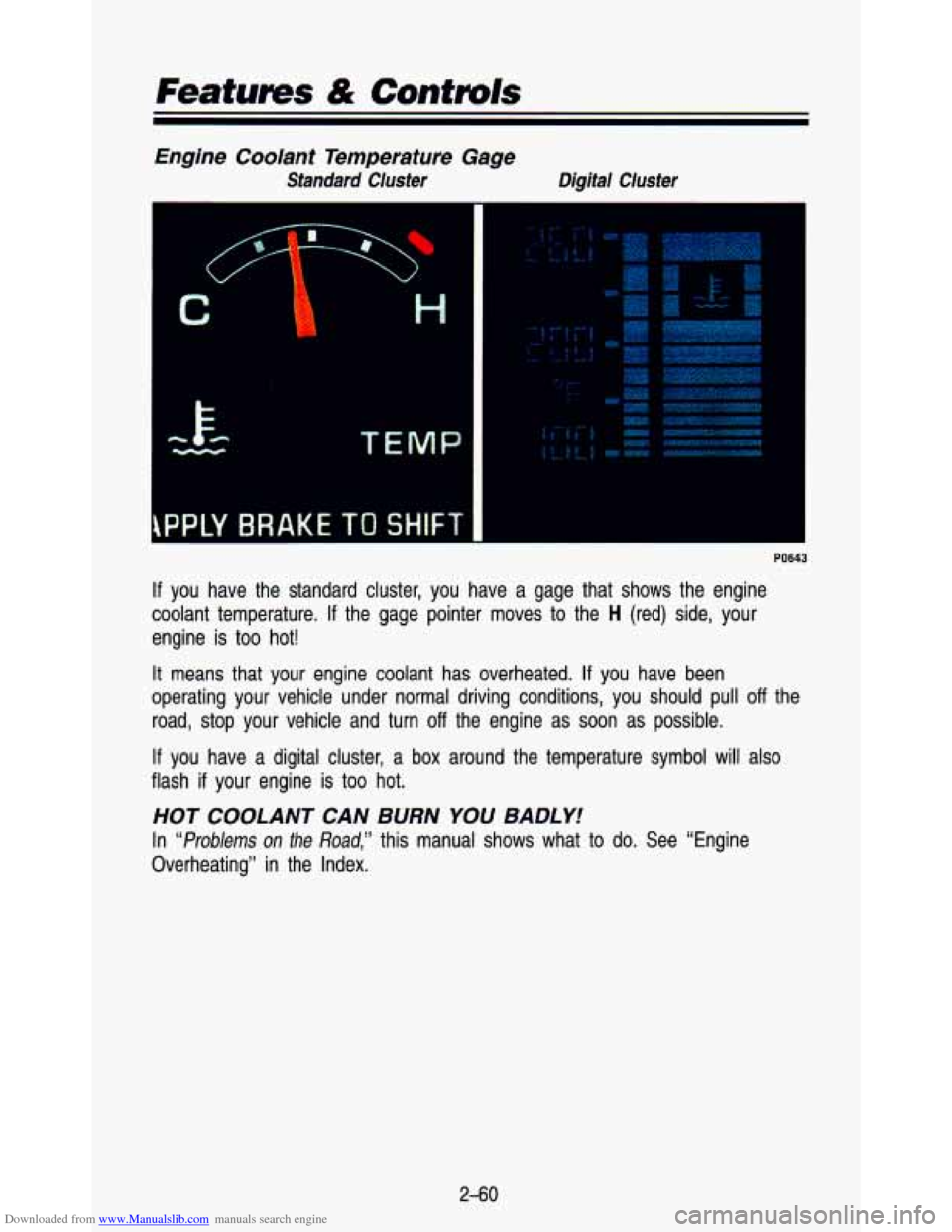
Downloaded from www.Manualslib.com manuals search engine Features & Controls
Engine Coolant Temperature Gage
Standard CIuster Digital Cluster
TEMP
PPLY BRAKE TO SHIFT
PO643
If you have the standard cluster, you have a gage that shows the\
engine
coolant temperature.
If the gage pointer moves to the H (red) side, your
engine is too hot!
It means that your engine coolant has overheated.
If you have been
operating your vehicle under normal driving conditions, you shou\
ld pull
off the
road, stop your vehicle and turn
off the engine as soon as possible.
If you have a digital cluster, a
box around the temperature symbol will also
flash
if your engine is too hot.
HOT COOLANT CAN BURN YOU BADLY!
In “Problems on the Road,” this manual shows what to do. See “Engine
Overheating” in the Index.
2-60
Page 125 of 345
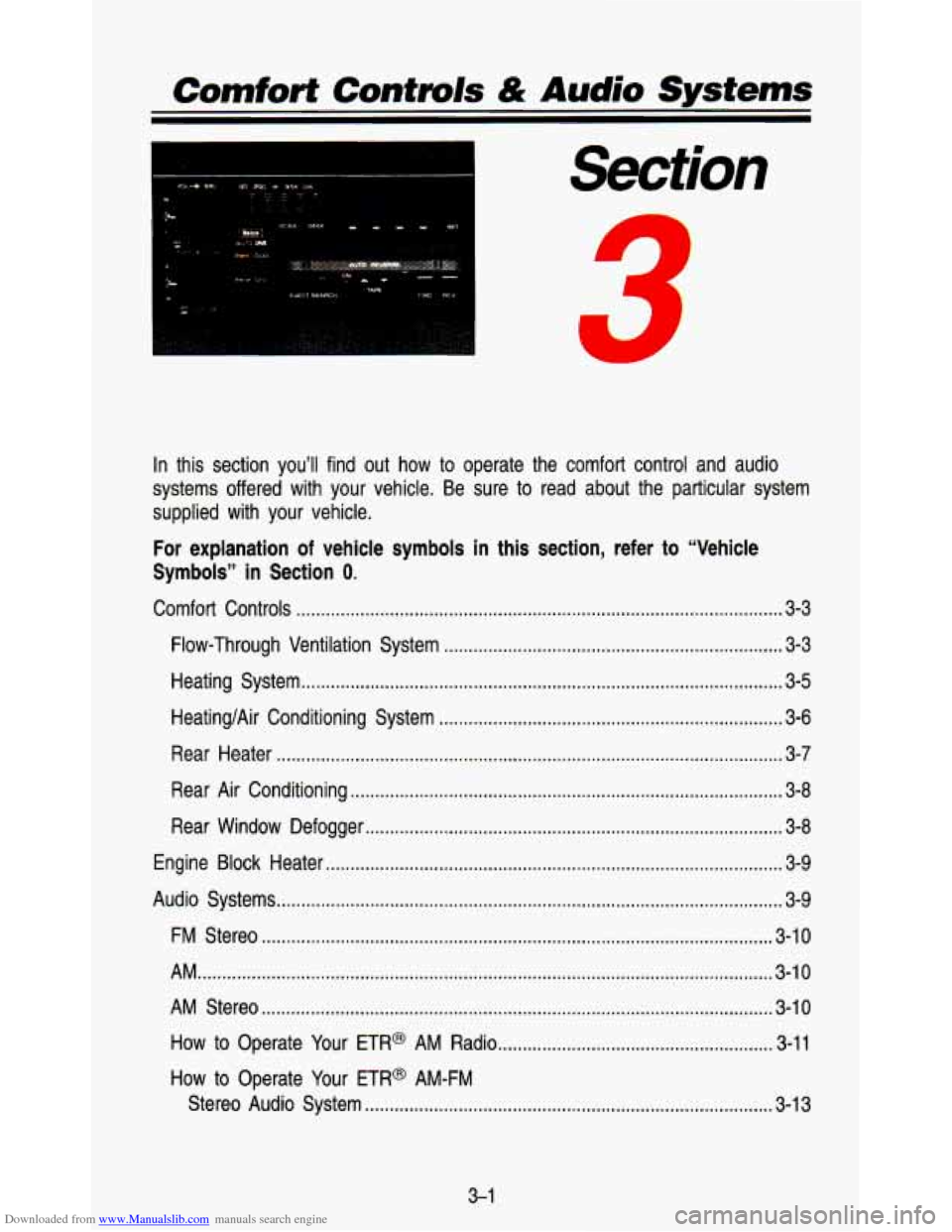
Downloaded from www.Manualslib.com manuals search engine Comfort Controls & Audio Systems
In this section you’ll find out how to operate the comfort control and audio
systems offered with your vehicle. Be sure to read about the \
particular system
supplied with your vehicle.
For explanation of vehicle symbols in this section, refer to “Vehicle
Symbols” in Section 0.
Comfort Controls ........................................................................\
........................... 3-3
Flow-Through Ventilation System
..................................................................... 3-3
Heating System
........................................................................\
.......................... 3-5
Heating/Air Conditioning System
...................................................................... 3-6
Rear Heater
........................................................................\
............................... 3-7
Rear Air Conditioning
........................................................................\
................ 3-8
Rear Window Defogger
........................................................................\
............. 3-8
Engine Block Heater
........................................................................\
..................... 3-9
Audio Systems
........................................................................\
............................... 3-9
FM Stereo ........................................................................\
................................ 3-1 0
AM.. ........................................................................\
........................................... 3-1 0
AM Stereo ........................................................................\
................................ 3-1 0
How to Operate Your ETR@ AM Radio ........................................................ 3-11
How to Operate Your ETR@ AM-FM
Stereo Audio System
........................................................................\
........... 3-1 3
3-1
Page 129 of 345
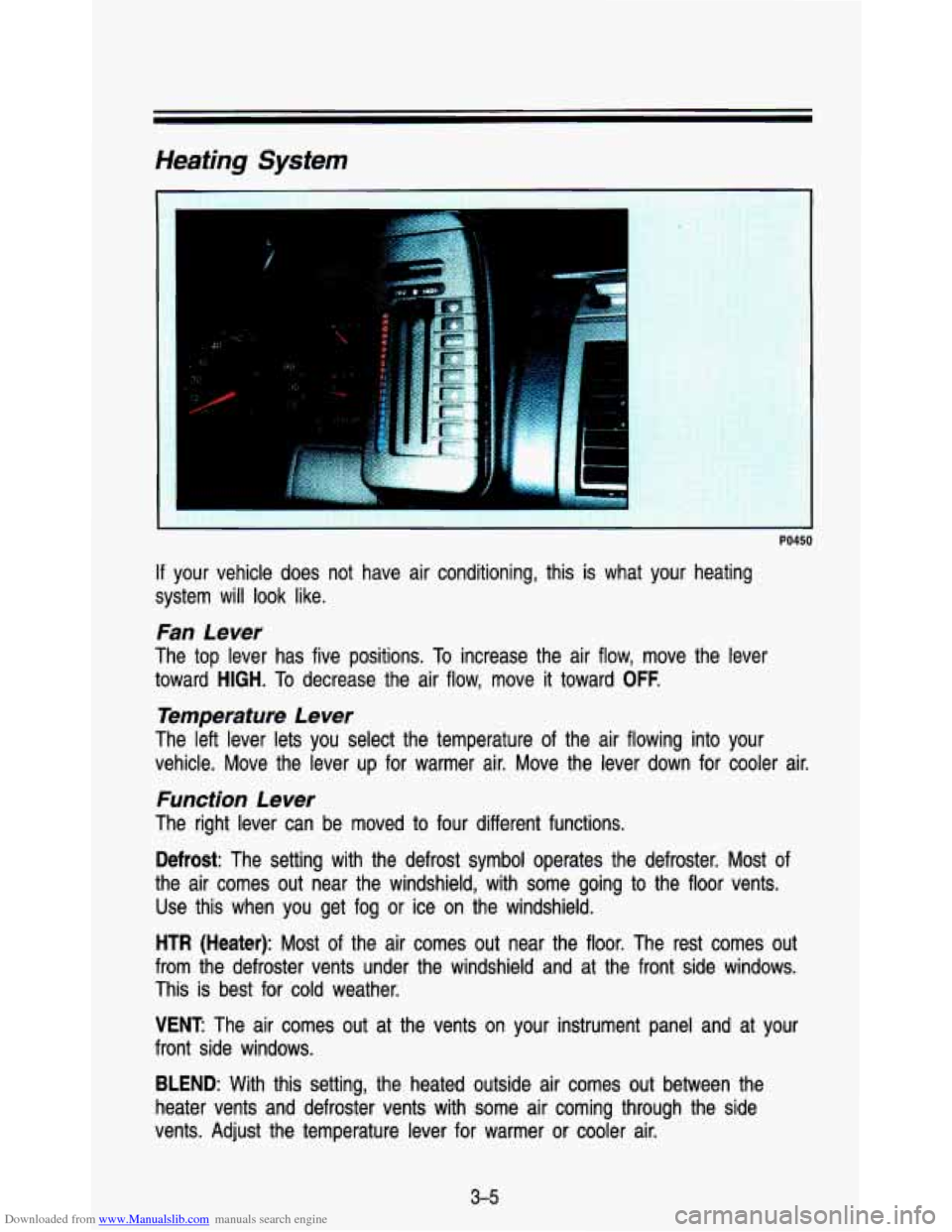
Downloaded from www.Manualslib.com manuals search engine Heating System
PO450
If your vehicle does not have air conditioning, this is what your heating
system will
look like.
Fan Lever
The top lever has five positions. To increase the air flow, move the lever
toward
HIGH. To decrease the air flow, move it toward OFF.
Temperature Lever
The left lever lets you select the temperature of the air flowing into your
vehicle. Move the lever up for warmer air. Move the lever dow\
n for cooler air.
Function Lever
The right lever can be moved to four different functions.
Defrost: The setting with the defrost symbol operates the defroster. Mos\
t of
the air comes out near the windshield, with some going to the floor vents.
Use this when you get fog or ice on the windshield.
HTR (Heater): Most of the air comes out near the floor. The rest comes out
from the defroster vents under the windshield and at the front side windows.
This is best for cold weather.
VENT: The air comes out at the vents on your instrument panel and \
at your
front side windows.
BLEND: With this setting, the heated outside air comes out between the
heater vents and defroster vents with some air coming through \
the side
vents. Adjust the temperature lever for warmer or cooler air.
3-5
Page 130 of 345
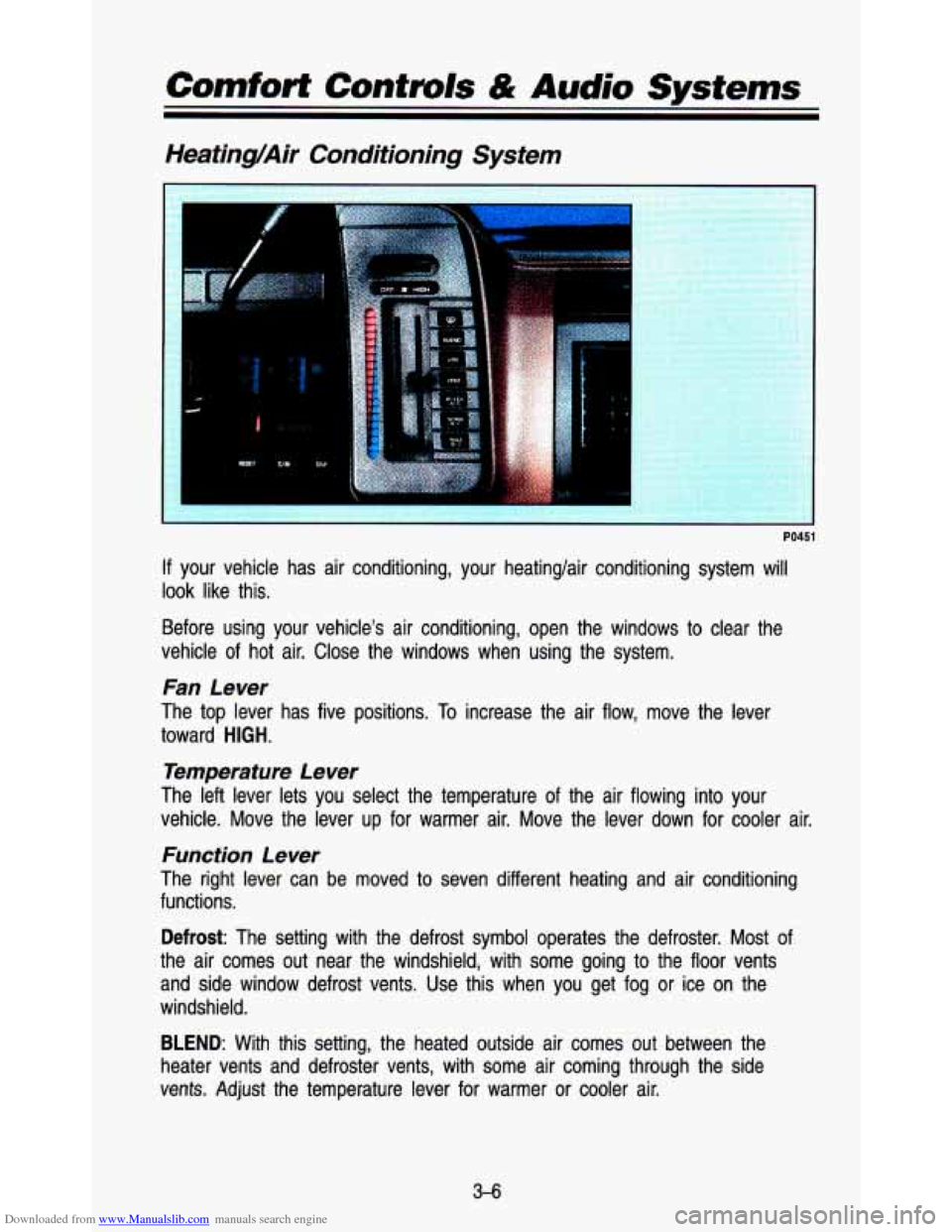
Downloaded from www.Manualslib.com manuals search engine HeatingAir Conditioning System
PO451
If your vehicle has air conditioning, your heating/air conditioning \
system will
look like this.
Before using your vehicle's air conditioning, open the windows to clear the
vehicle of hot air. Close the windows when using the system.
Fan Lever
The top lever has five positions. To increase the air flow, move the lever
toward
HIGH.
Temperature Lever
The left lever lets you select the temperature of the air flowing into your
vehicle. Move the lever up for warmer air. Move the lever down for cooler \
air.
Function Lever
The right lever can be moved to seven different heating and air conditioning
functions.
Defrost: The setting with the defrost symbol operates the defroster. Mos\
t of
the air comes out near the windshield, with some going to the floor vents
and side window defrost vents. Use this when you get fog or ice on the
windshield.
BLEND: With this setting, the heated outside air comes out between th\
e
heater vents and defroster vents, with some air coming through \
the side
vents. Adjust the temperature lever for warmer or cooler air.
3-6
Page 133 of 345

Downloaded from www.Manualslib.com manuals search engine does not get too hot. If the window still isn’t clear, turn the defogger on
again.
Scraping the inside of your rear window could cut and damage th-
defogger. Your warranty would not cover this damage.
A*A don’t put
decals there, you might have to scrape them
I
Engine Block Heater
If you use the optional engine block heater before starting yo\
ur engine, your
heating system will produce warmer air faster to heat the pass\
enger
compartment in cold weather. See “Engine Block Heater” in the Index.
Audio Systems
Your Dekoa audio system has been designed to operate easily and give
years of listening pleasure. But you will get the most enjoyment out of it,
if
you acquaint yourself with it first. Find out what your Delco@ system can do
and how
to operate all its controls, to be sure you’re getting the mos\
t out of
the advanced engineering that went into it.
CAUTION
Hearing damage from loud noise is almost undetectable until it is too
late. Your hearing can adapt to higher volumes
of sound. Sound that
seems normal can be loud and harmful to your hearing. Take
’ precautions by adjusting the volume control on your radio to a safe
sound level before hearing adapts to it.
To help avoid hearing loss or damage:
Adjust the volume control to the lowest setting.
Increase volume slowly until you hear comfortably and clearly.
3-9
Page 201 of 345
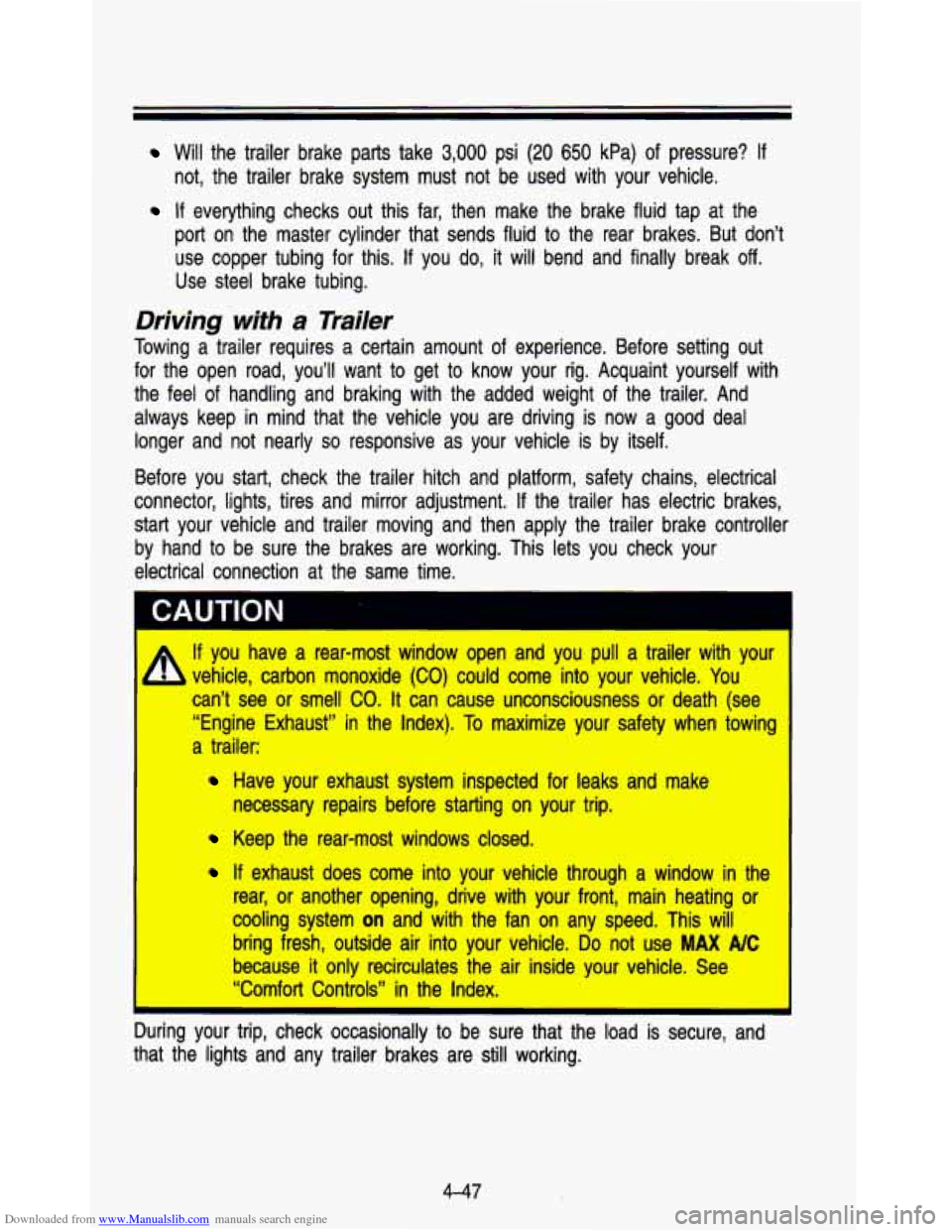
Downloaded from www.Manualslib.com manuals search engine Will the trailer brake parts take 3,000 psi (20 650 kPa) of pressure? If
not, the trailer brake system must not be used with your vehi\
cle.
if everything checks out this far, then make the brake fluid tap at the
port on the master cylinder that sends fluid to the rear brak\
es. But don’t use copper tubing for this.
If you do, it will bend and finally break off.
Use steel brake tubing.
Driving with a Trailer
Towing a trailer requires a certain amount of experience. Before setting out
for the open road, you’ll want to get to know your rig. Acquaint yourself with
the feel of handling and braking with the added weight of the trailer. And
always keep in mind that the vehicle you are driving is now a good deal
longer and not nearly
so responsive as your vehicle is by itself.
Before you start, check the trailer hitch and platform, safety \
chains, electrical
connector, lights, tires and mirror adjustment.
If the trailer has electric brakes,
start your vehicle and trailer moving and then apply the trail\
er brake controller
by hand to be sure the brakes are working. This lets you check your
electrical connection at the same time.
If you have a rear-most window open and you pull a trailer with your
vehicle, carbon monoxide (CO) could come into your vehicle. You
can’t see or smell CO. It can cause unconsciousness or death (see
“Engine Exhaust” in the Index).
To maximize your safety when towing
a trailer:
Have your exhaust system inspected for leaks and make
Keep the rear-most windows closed.
If exhaust does come into your vehicle through a window in the
rear, or another opening, drive with your front, main heating \
or
cooling system
on and with the fan on any speed. This will
bring fresh, outside air into your vehicle.
Do not use MAX NC
because it only recirculates the air inside your vehicle. See
“Comfort Controls” in the Index.
necessary repairs before starting
on your trip.
During your trip, check occasionally to be sure that the load is secure, and
that the lights and any trailer brakes are still working.
4-47
Page 202 of 345
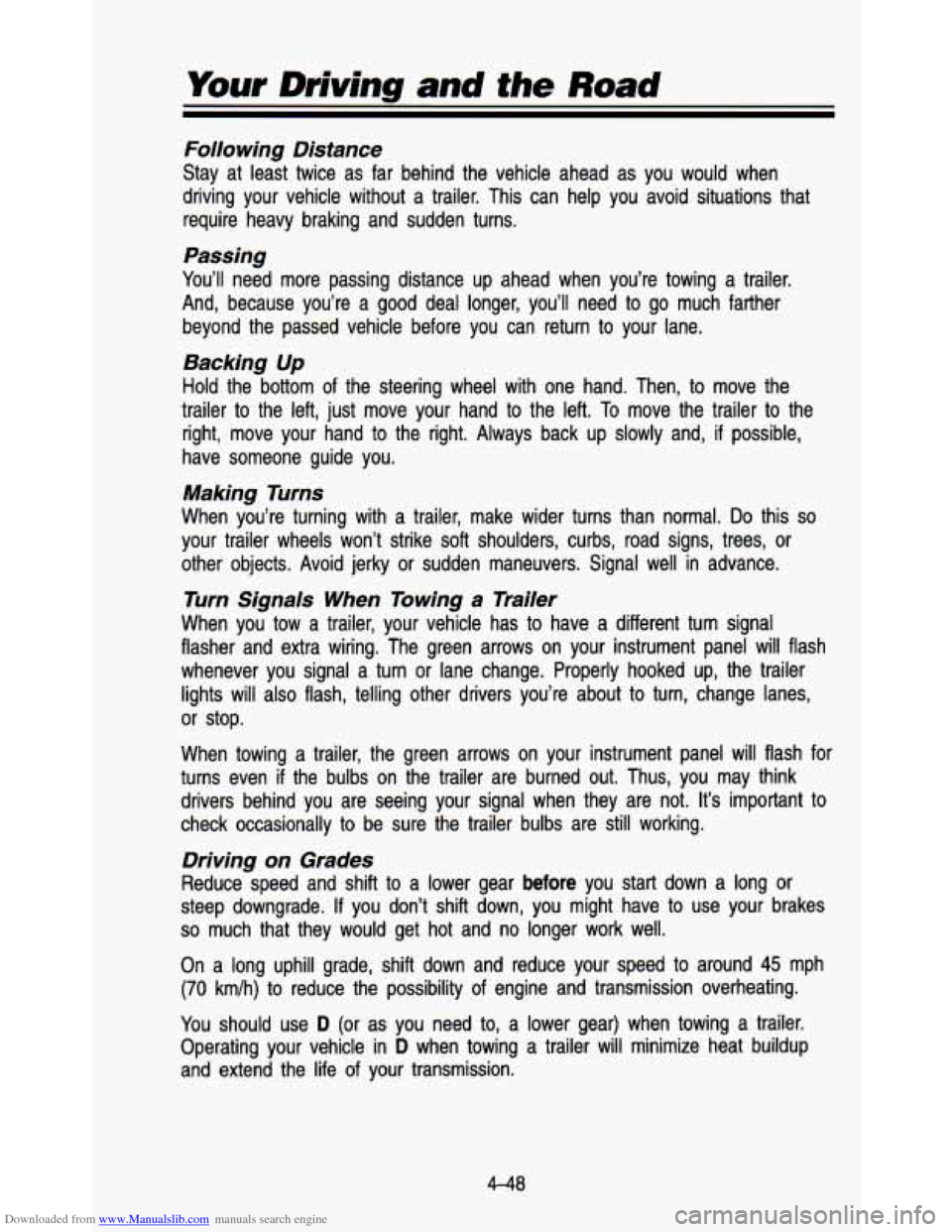
Downloaded from www.Manualslib.com manuals search engine Your Driving and the Road
Following Distance
Stay at least twice as far behind the vehicle ahead as you w\
ould when
driving your vehicle without a trailer. This can help you avoi\
d situations that require heavy braking and sudden turns.
Passing
You’ll need more passing distance up ahead when you’re to\
wing a trailer.
And, because you’re a good deal longer, you’ll need
to go much farther
beyond the passed vehicle before you can return
to your lane.
Backing Up
Hold the bottom of the steering wheel with one hand. Then, to move the
trailer to the left, just move your hand to the left.
To move the trailer to the
right, move your hand to the right. Always back up slowly and\
, if possible,
have someone guide you.
Making Turns
When you’re turning with a trailer, make wider turns than n\
ormal. Do this so
your trailer wheels won’t strike soft shoulders, curbs, road \
signs, trees, or
other objects. Avoid jerky or sudden maneuvers. Signal well in advance.
Turn Signals When Towing a Trailer
When you tow a trailer, your vehicle has to have a different turn signal
flasher and extra wiring. The green arrows on your instrument \
panel will flash
whenever you signal a turn or lane change. Properly hooked up,\
the trailer lights will also flash, telling other drivers you’re about to turn, change lanes,
or stop.
When towing a trailer, the green arrows on your instrument pan\
el will flash for
turns even
if the bulbs on the trailer are burned out. Thus, you may think \
drivers behind you are seeing your signal when they are not. \
It’s important to
check occasionally
to be sure the trailer bulbs are still working.
Driving on Grades
Reduce speed and shift to a lower gear before you start down a long or
steep downgrade. If you don’t shift down, you might have to use your brakes
so much that they would get hot and no longer work well.
On a long uphill grade, shift down and reduce your speed to \
around
45 mph
(70 km/h) to reduce the possibility of engine and transmission overheating.
You should use
D (or as you need to, a lower gear) when towing a trailer.
Operating your vehicle in
D when towing a trailer will minimize heat buildup
and extend the life
of your transmission.
4-48